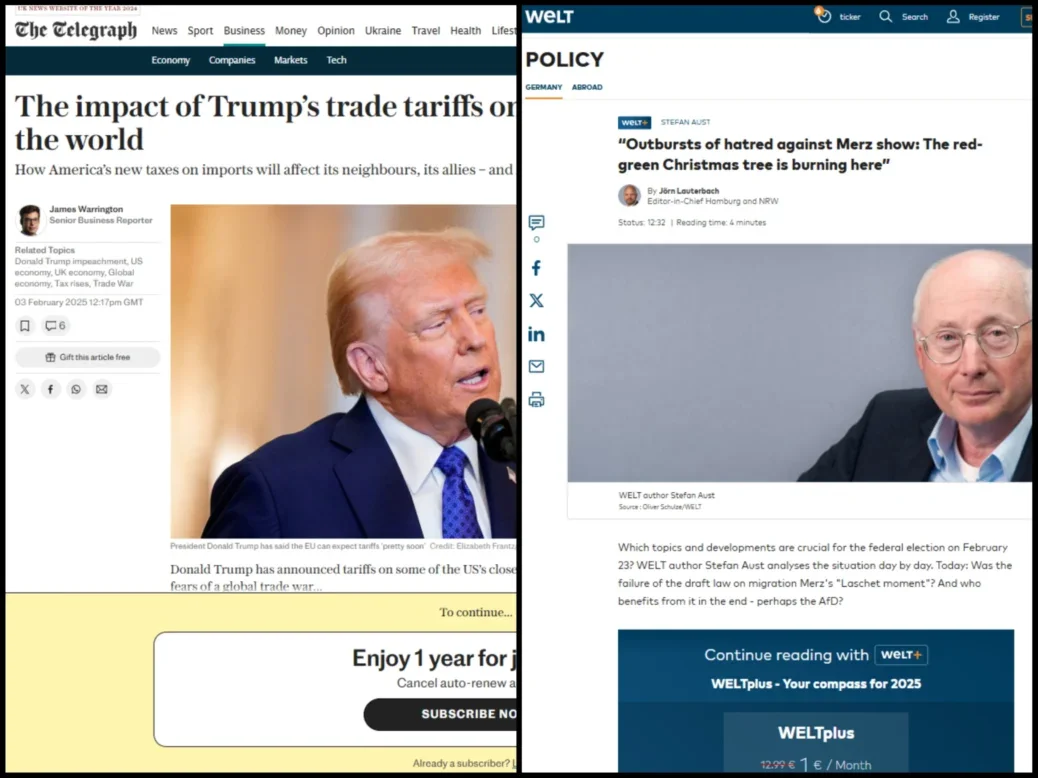
Showing a standfirst or intro below the headline of a paywalled article “significantly decreases” the odds of visitors clicking the subscribe button on the page, according to new research looking at local newspapers in Germany and Austria.
The study by the Department of Media and Communication at LMU Munich found that displaying a standfirst between a headline and text on an otherwise locked paywalled article decreased the odds of someone hitting subscribe by 86.3%.
Allowing non-subscribers to read the intro similarly decreased the odds of someone hitting subscribe by 72.2%.
“A possible explanation is that a standfirst and/or an intro can provide considerable information about the article not contained within the headline,” the study said. “Standfirsts typically contain ‘the most important facts and ideas’ in the article and the intro, as the beginning of the article, will often also contain important information as articles often follow the ‘inverted pyramid’ structure.
“As a result, visitors may obtain enough information from a well-formulated stand-first and/ or intro to feel that they have been sufficiently informed, and therefore feel no need to read further, let alone pay to do so. This is especially the case given online news consumers’ tendency to quickly browse news to form an impression of current events, rather than seeking in-depth knowledge or opinions.”
Teasing paywalled articles too much lessens odds of people paying
The study looked at whether visitors clicked “subscribe” on paywalled article pages for 21 regional and local newspapers in Germany and Austria in May and August 2022.
It said it went beyond previous studies because it used actual visitor behaviour instead of people’s self-reported willingness to pay. The large audience size of some of the newspapers included in the study led the researchers to say they believed their findings have relevance to national brands as well as local titles.
The research also looked at whether people then completed the subscription journey by paying on the next page – finding that discounts were the best technique to encourage them to do so.
The data used came from the Digital Revenue Initiative (DRIVE) project, a German data-sharing initiative designed to help publishers learn from each other.
The research paper concluded that the findings “present news websites with a dilemma, as the presence of any of the teaser elements negatively correlates with visitors starting the subscription journey.
“In practice, it would be unlikely that a news website would choose to display only the headline of a paywall locked article.
“Although showing a picture was negatively correlated with clicking the subscribe-now button, that correlation was not statistically significant, which may make it a good choice as a teaser element alongside the headline as it gives the reader a taste of the news article without significantly reducing the odds that they click on the ‘subscribe now’ button.”
Price may not be ‘important factor’ but discounts ‘give feeling of tangible benefit’
Once users had clicked through to the subscription page, the research found there was a “significant positive correlation between the provision of a discount and visitors finally subscribing” as discounts increased the odds of someone paying by 3.35 times.
The research said that although giving away free or subsidised smart devices (such as a smartwatch) to new subscribers was less effective but “a strategy that news publishers should consider.”
Other factors, including offering an e-paper, the length of a trial period or giving away small gifts, showed no significant associations with whether someone chose to subscribe.
The researchers suggested publishers should save the budget they might have used on small gifts for new subscribers and use it instead to offer discounts.
The study also said: “Some studies have suggested that people care only about whether online news is charged for rather than how much is charged, and as most news websites have quite similar prices, which are also fairly affordable, people may not think the level of price an important factor in the subscription decision.
“However, offering a direct discount may provide visitors with the feeling that they are receiving a tangible benefit and encourage them to subscribe.”
The researchers noted that “in light of the insignificant correlation between trials and people subscribing, a shortening of the trial period might generate more income for news publishers without having negative effects on the propensity to subscribe”.
The research found that none of the offer/pricing strategies made a significant difference for local visitors, although for non-local visitors both a discount and giving away free or subsidised smart devices significantly increased the odds of them subscribing.
The study noted that despite the findings it may be easier to nudge people into paying in some other markets, as Germany and Austria has a lower-than-average propensity to pay.
The researchers similarly noted that the “finding of no statistically significant correlation between price and subscribing may not generalise to markets (eg Finland or Norway) where higher proportions of those who do not pay for online news say they would be willing to pay something for online news than is the case in Germany and Austria”.
According to the Reuters Institute Digital News Report 2024, 13% of people in Germany and 14% in Austria said they had paid for online news in the previous year – below the average across 20 markets of 17% (but above the UK in joint bottom on 8%).
The UK (69%), Germany (68%) and Austria (60%) had much higher levels of non-payers in the Reuters study who said they would not be willing to pay anything for online news compared to Norway (45%) and Finland (43%).
Email pged@pressgazette.co.uk to point out mistakes, provide story tips or send in a letter for publication on our "Letters Page" blog
